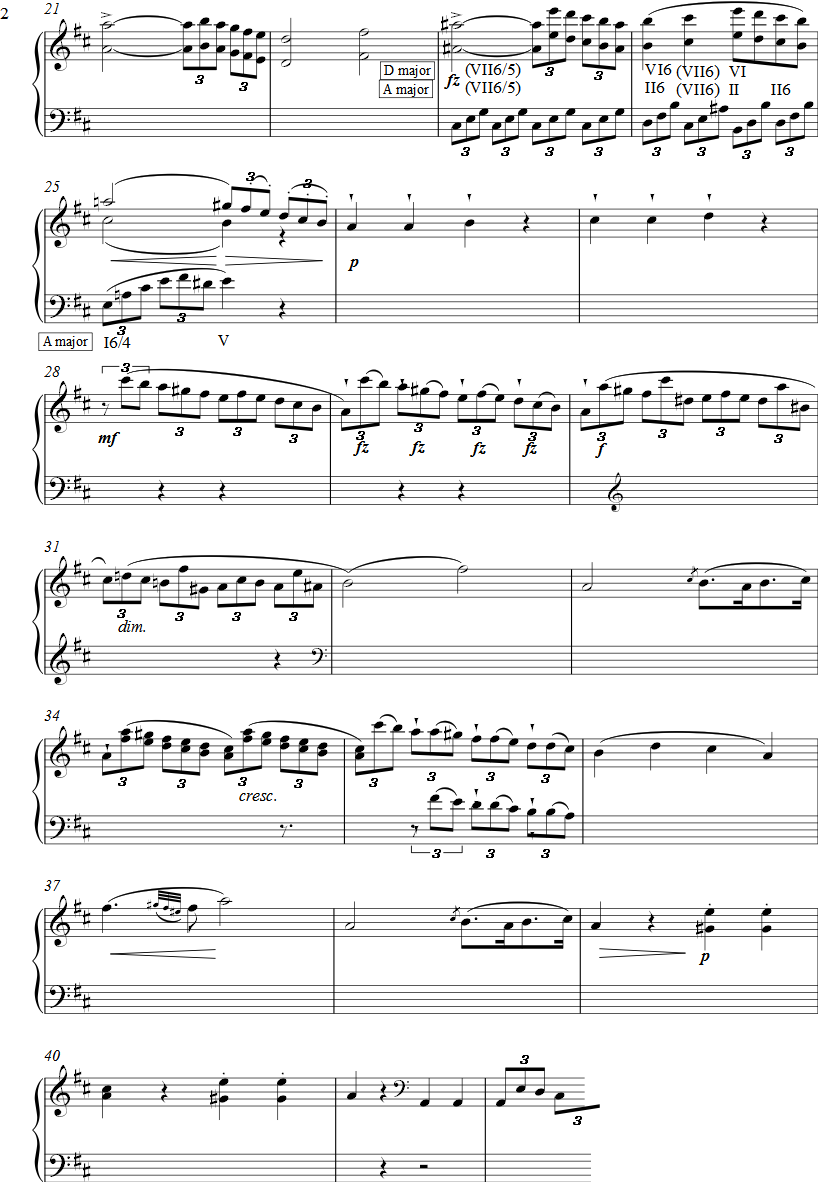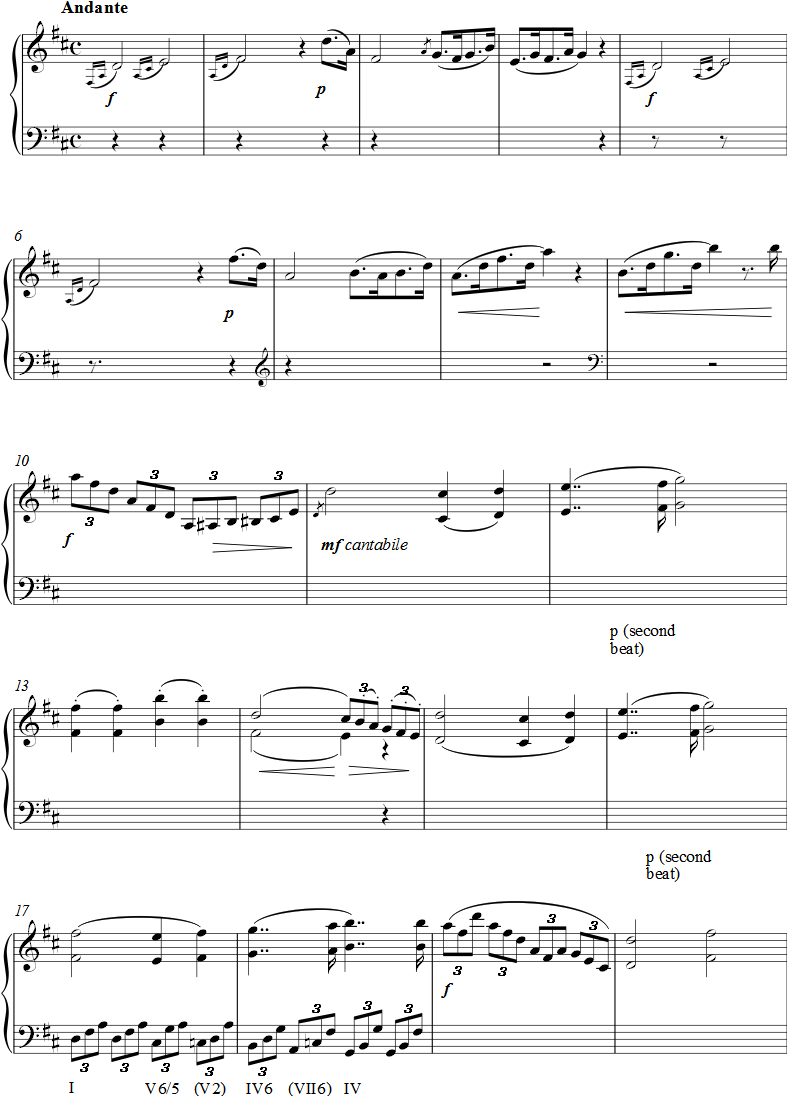Some exercises for harmonic hearing (which you may use as 'studies'
for the Haydn example) You
can find the answers here.
And
here is a pdf you can work on.
I am sorry that these exercises are piano/midi. I know, I should
rather make recordings... ;) |
|
|
When you want to
use the materials below (and elsewhere on this website) you must install
the browser plugin SCORCH(by
Sibelius Music). The plugin allows you
-
to see the scores
-
to listen to them (midi)
-
change the tempo, and transpose them to another key (works
fine normally, only sometimes it goes entirely wrong)
|
Om dit materiaal te kunnen gebruiken moet
op je computer het programmaatje 'scorch' (van Sibelius) zijn ge?nstalleerd.
Je kunt de oefeningen dan
-
bekijken
-
beluisteren (als midi, dus mooi is het niet echt..)
-
in een ander tempo afspelen en transponeren naar een andere
toonsoort (gaat meestal goed, en soms goed fout..)
|
|
|
|
| 1. |
This exercise contains two periods. Only these chords are used: I
I6 V(7) V4/3 (as passing chord) and IV .
-
label the cadences first
-
notate the bass
-
label all chords
|
|
You can either use the Scorch file below, or use this
audio (mp3) file:  (which
has a slightly better sound quality) (which
has a slightly better sound quality)
|
|
|
|
|
|
|
| 2. |
This exercise contains two periods as well, though the second period
is extended. These chords are used: I I6
V V6 V7 V6/5 V4/3
IV IV6 II6
-
label the cadences first
-
notate the bass
-
label all chords
You may of course distinguish between IV and II6 by listening to the inversion;
but: maybe even more clear, there is a diffence in sound quality:
IV is a minor triad, II is dimished (in major that would
be: V=major, II=minor) |
You can either use the Scorch file below, or use this
audio (mp3) file:  (which
has a slightly better sound quality) (which
has a slightly better sound quality)
|
|
|
|
|
|
| 3. |
This exercise is especially using I and V and their inversions [ I6,
and I6/4 as suspension to V, V6 and root position and all inversions of
V7 ]
-
label the cadences first
-
notate the bass
-
label all chords
|
You can either use the Scorch file below, or use this
audio (mp3) file:  (which
has a slightly better sound quality) (which
has a slightly better sound quality)
|
|
|
|
|
|
| 3b. |
Just to compare with exercise 3: here is the same exercise in
minor
Remember: in major keys I and IV are major triads, VI is a minor
triad. In minor keys it is the opposite: I and IV are minor triads,
VI is a major triad. V and V7 are the same in major and minor keys:
major triad or dominant seventh chord. |
You can either use the Scorch file below, or use this
audio (mp3) file:  (which
has a slightly better sound quality) (which
has a slightly better sound quality)
|
|
|
|
|
|
| 4. |
Exercise, especially to distinguish between IV and II6.
Remember: in major keys IV is a major triad, and II is minor. In minor
keys IV is a minor triad, and II is diminished. |
You can either use the Scorch file below, or use this
audio (mp3) file:  (which
has a slightly better sound quality) (which
has a slightly better sound quality)
|
|
|
|
|
|
| 5. |
Haydn, Piano Sonata in D major Hob. XVI: 51, exposition
of the first movement.
-
Listen to the entire exposition, and check in the score where the
key change to A major takes place, and how it is done (I notated that in
the score).
-
Notate the bass; from bar 11 the left hand is often moving in eights
notes triplets; I would only notate the beats (mostly: 4 notes per measure).
-
Describe the cadences (as PAC, DC etc.); notate the approriate terms
in the right spots in the score.
-
Listen to the harmony, and write the scale degrees (Roman
numbers) under the piano part in the score (with inversions where these
are used). At two spots I added 'p' at the left hand stave: the sounds
at these moments are not really harmonies, but sounds caused by the passingnotes.
The surrounding chords are the issue, not the 'p-sounds' - do not try to
explain them... In measure 35 only the first beat should be seen as a harmony
(that's why you see there the second, third and fourth beats notated already).
In measures 30/31 a 'special' harmonic pattern is used; do you recognize
it maybe?
|
|
recording:
This is a pretty clear recording:
Spotify:
Rudolf Buchbinder – Haydn
: Piano Sonata No.61 in D major Hob.XVI, 51 : I Andante
(alternative: browser link): Rudolf
Buchbinder – Haydn : Piano Sonata No.61 in D major Hob.XVI, 51 : I Andante
)
--------
|
|
|
|
|
|
 |
|
|
|

